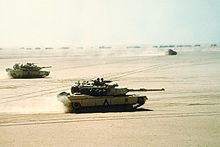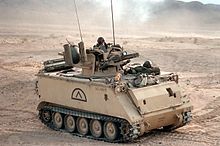- Battle of Wadi Al-Batin
-
Battle of Wadi Al-Batin Part of the Persian Gulf War 
Soviet made T-12 Rapira antitank gun, the main weapon used by the Iraqis during the battleDate 15–20 February 1991 Location Iraq Result Iraqi victory
Successful American feint attackBelligerents  United States
United States Iraq
IraqCommanders and leaders  Fred Franks
Fred Franks Yaiyd Khalel Zaki
Yaiyd Khalel ZakiCasualties and losses 3 dead
9 wounded
1 M-113 vehicle destroyed
1 Bradley destroyed
1 Bradley damaged
1 Abrams tank damaged7 captured
5 tanks destroyed
20 artillery pieces destroyedInvasion of Kuwait
Kuwaiti Bridges – Dasman Palace – FailakaCoalition intervention
Ad-Dawrah – Qurah – Maradim – Khafji – Bubiyan – Wadi Al-BatinAir campaign
Air-Air combat – "Package Q" Air StrikeLiberation of Kuwait
Order of battle – 67 Easting – 73 Easting – Al Busayyah – Phase Line Bullet – Medina Ridge – Highway of Death – Jalibah – NorfolkPost-ceasefire
Rumaila – SafwanThe Battle of Wadi Al-Batin or Battle of Ruqi Pocket took place before the beginning of the Desert Storm operations on 16 February 1991. This is not to be confused with the "Battle of Wadi Al-Batin" which was fought later in the four-day ground war between elements of the U.S. 3d Armored Division and the Iraqi Republican Guard.
Iraqis thought that Coalition forces were prepping the Wadi Al-Batin for the main attack. The desired effect was that the Iraqis would think that the main coalition ground attack would come up the Wadi Al Batin, a natural invasion route, and they would therefore reinforce their forces there, at the expense of the Western flank, where VII Corps would conduct the main attack.
Contents
Deception movements
As American forces secretly redeployed from the southern Kuwaiti border to the northwest, "deception cells" were left in the south. This units built a computer-generated electronic network which simulated an intense VHF-UHF wireless traffic. When the Iraqi intelligence caught these "radio calls" -some of them only static hiss- they immediately concluded that the bulk of American forces were still entrenched south of the border.[1] Another master piece of military dupery was the building of fake bunkers and the shuttling of bogus vehicle convoys, only intended to churn up great clouds of dust. Decoy tanks added to the deception of the unsuspecting Iraqi army.[2]
The Feint
By mid February, General Franks ordered U.S. 1st Cavalry Division to conduct a thrust along the border between Iraq and Kuwait. This misdirection would allow the coalition forces to perform the famous "Hail Mary" to the West as the Iraqis focused on the Wadi.
Operation Berm Buster
On 15 February, TF 1-32, supported by the divisions 8th Engineers, breached the defensive berm built by the Iraqis on the frontier.[3] The 155 mm howitzers of the Division's 3-82nd Field Artillery Regiment kept the Iraqi positions under fire in the course of this operation,[4] pounding seven pre established targets. The Iraqis retaliated with sporadic mortar fire.[3]
Operation Red Storm
The first phase of the feint was a night attack. Fire support from the 82nd Field Artillery Regiment was required again. The artillery was temporarily reduced to 50% percent when a howitzer was stuck in an antitank ditch, preventing the rest of the convoy from moving ahead. Two soldiers were injured in the accident. Undeterred, the Regiment carried out a precision shelling on an Iraqi radar facility just before 1:00 AM of 16 February. The 82nd immediately moved out of the area after the mission was completed, and a raid by Apache helicopters hit selected targets deep behind the Iraqi lines.[3]
Operation Knight Strike
 M1 Abrams in the Gulf War
M1 Abrams in the Gulf War
On the morning of 18 February, the 1st Cavalry followed up the artillery attack with a Reconnaissance in Force by Task Force 1-5 CAV (Black Knights) of the 2nd Black Jack Brigade, 1st Cavalry Division. The Task Force consisted two M1-A1 Abrams Tank Companies, two M2-A1 Bradley Fighting Vehicle Companies, an M901 Anti Tank Company, Command and Control elements from the Headquarters of 2nd Brigade, elements of 1st ADA (Stinger and Vulcan Anti Aircraft Systems) and in a combat trains location, elements of the forward support battalion (C Co medical evac). One of the first reaction of the Iraqis, besides firing sporadic mortar rounds, was to set oil trenches on fire.[3][5]
On 20 February, 1-5 CAV broke the border berm in two different points, and after evading a minefield they crossed to the west bank of the wadi. Then the troops of the 2nd Brigade maneuvered northwards for six miles.[6] Their orders were "Do not become decisively engaged, and do not attrit your force."[7] At midday, a scout platoon reported that they were exchanging fire with the enemy. Seven Iraqi soldiers laid down their weapons.[6] As reinforcements were pushing forward, the column was ambushed by Iraqi troops using mortars and T-12 anti-tank guns hidden on the reverse slope of a low ridge. Intense direct and indirect fire erupted. The Brigade commander, Col. Randolph House, was forced to retreat rearguards after his M-113 vehicle was nearly hit by several shells.[5][8]
Before a skirmish line could be formed, a Vulcan M-113 vehicle was destroyed by a 100 mm round. The gunner died instantly. A Bradley AFV spraying 30 mm fire on Iraqi trenches was also hit;[8] a Sergeant was killed and two other men were wounded as result.[9] Another Bradley, commanded by Staff Sergeant Christopher Chichon, came forward to evacuate these casualties.[10] The armored vehicle was struck in the turret by a round which shattered its TOW launcher. While rescuing wounded personnel from the first Bradley, Private Ardon Cooper received several shrapnel injuries, and died later from heavy loss of blood.[8] He was posthumously awarded the Silver Star.[10] Sergeant Chichon's Bradley was still operational, and its crew managed to withdraw it from the line of fire, after picking up the wounded.[10] The battle raged for about an hour; after pounding the Iraqi positions with heavy artillery and A-10 air strikes, 1-5 fell back to the berm. During the pull-out, an Abrams tank tank hit a mine and was heavily damaged. The Iraqi defenders lost five tanks and 20 artillery pieces.[10] American casualties amounted to three dead and nine wounded. The wisdom of a full-daylight operation was the subject of some criticism, but the Iraqi army remained convinced that the Coalition invasion would take place from the south.[9]
Notes
References
- Atkinson, Rick: Crusade, The untold story of the Persian Gulf War.Houghton Mifflin Company, 1993. ISBN 0395710839
- Halberstadt, Hans: Desert Storm Ground War. Osceola, WI, Motorbooks International, 1991. ISBN 0879385618
- Jaco, Charles: The complete idiot's guide to the Gulf War. Alpha Books, 2002. ISBN 0028643240
- Lowry, Richard: The Gulf War Chronicles: A Military History of the First War with Iraq. iUniverse, 2003. ISBN 0595296696
- www.hoskinson.net.
- US 1st Cavalry Div..
Categories:- 1991 in Iraq
- Battles of the Gulf War
- Battles involving the United States
- Tank battles involving the United States
Wikimedia Foundation. 2010.

